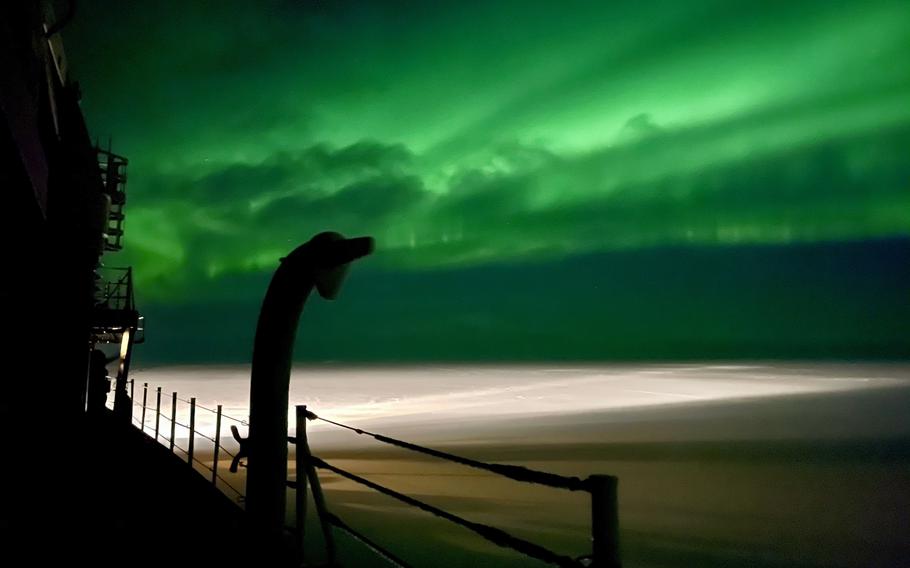
The Aurora Borealis as seen from the Coast Guard Cutter Polar Star while patrolling in the Chukchi Sea, Dec. 21, 2020. Multiple explosions on the sun this week have unleashed four bursts of plasma from the sun’s corona toward Earth. Known as coronal mass ejections, or CMEs, these blasts are expected to consolidate into a supersize CME capable of triggering a strong geomagnetic storm and aurora visible in the northern United States and Europe on Thursday night, Nov. 30, 2023, into early Friday. (Joseph Soderling/U.S. Coast Guard)
Multiple explosions on the sun this week have unleashed four bursts of plasma from the sun’s corona toward Earth. Known as coronal mass ejections, or CMEs, these blasts are expected to consolidate into a supersize CME capable of triggering a strong geomagnetic storm and aurora visible in the northern United States and Europe on Thursday night into early Friday.
Solar storms can generate geomagnetic activity that disrupts radio communications and GPS navigation services, although this storm may be strong enough to produce only an aurora borealis, or northern lights.
How far south the aurora will be visible is uncertain, and cloud cover may obscure the view in some regions, but it’s possible the lights could be seen with the naked eye across parts of the northern Plains, Midwest and Northeast. There’s an outside chance they’ll be faintly visible into the Mid-Atlantic, southern Plains and parts of California, far away from light pollution.
“The largest solar storms have the potential to disrupt our technological infrastructure, but this week’s incoming storm is not one of them,” Ryan French, a solar physicist at the National Solar Observatory, said in an email. “The incoming solar storm is expected to be large enough to provide a northern lights show, but not large enough to cause any major technological disruption. [There] may be minor issues relevant to niche industries only.”
The strongest explosion, or solar flare, was detected Tuesday by NASA’s Solar Dynamics Observatory satellite. The flare fell just short of category X, the strongest category on the solar flare scale. It produced a pulse of extreme radiation that “blacked out shortwave radio communications across the South Pacific Ocean and parts of the Americas ... for as much as an hour,” according to SpaceWeather.
The impacts of solar flares on Earth are almost immediate, with bursts of electromagnetic radiation usually arriving in about eight minutes, while associated CMEs typically take two to three days to arrive. Satellite imagery showed a halo cloud expanding away from the sun. Halo CMEs are indicative of plasma heading directly toward Earth.
The CME sparked by Tuesday’s solar flare was forecast to merge with at least two other CMEs out ahead of it and become a “cannibal” CME that could produce a G3 geomagnetic storm, SpaceWeather said. The National Oceanic and Atmospheric Administration’s Space Weather Prediction Center was forecasting a G3 storm by Thursday night into Friday. G3 storms, described as “strong” on NOAA’s 1 to 5 geomagnetic storm scale, bring the potential for intermittent disruption of satellite navigation and high-frequency radio communications as well as generating northern lights that are visible as far south as Illinois and Oregon.
CMEs can carry as much as 10 billion tons of solar material. Cannibal CMEs are relatively rare but are more common near the peak of the sun’s 11-year solar cycle, which NOAA expects to occur between January and October 2024.
A NASA space weather model estimates that the geomagnetic storm will strike Earth around midday Friday, but it could arrive as soon as Thursday.
The colorful aurora displays associated with geomagnetic storms are most often seen near the earth’s poles, but the strongest CMEs can result in the aurora being visible farther south or north into the mid-latitudes, depending on whether the light phenomena are aurora borealis or aurora australis, the latter occurring around the South Pole.
The University of Alaska’s aurora forecast predicts that the northern lights will be visible overhead late Thursday night into Friday morning as far south as Portland, Ore.; Cheyenne, Wyo.; Lincoln, Neb.; Springfield, Ill.; and New York City, away from city lights. It says the aurora might be visible low on the horizon as far south as Carson City, Nev.; Oklahoma City; and Raleigh, N.C. Clouds could block the view in some places with the best viewing conditions expected in the Upper Midwest, northern United Kingdom and Norway, according to Space Weather Watch.
“Late Thursday night currently has the best chance of aurora ... but forecasting these events [is] complicated, especially with three eruptions arriving within a relatively short window,” French said. “The G3 outcome is currently the most probable prediction, but results either side of this range are also possible.”
Earlier this month, a G3 geomagnetic storm produced vibrant colors visible to the naked eye near the U.S.-Canada border and appearing as a faint glow as far south as Texas and North Carolina.
Locations far from city lights are best for seeing aurora, especially the farther south you are. Sometimes, aurora low on the horizon in more-southern latitudes can be captured with long camera exposures even if they are not visible to the naked eye.